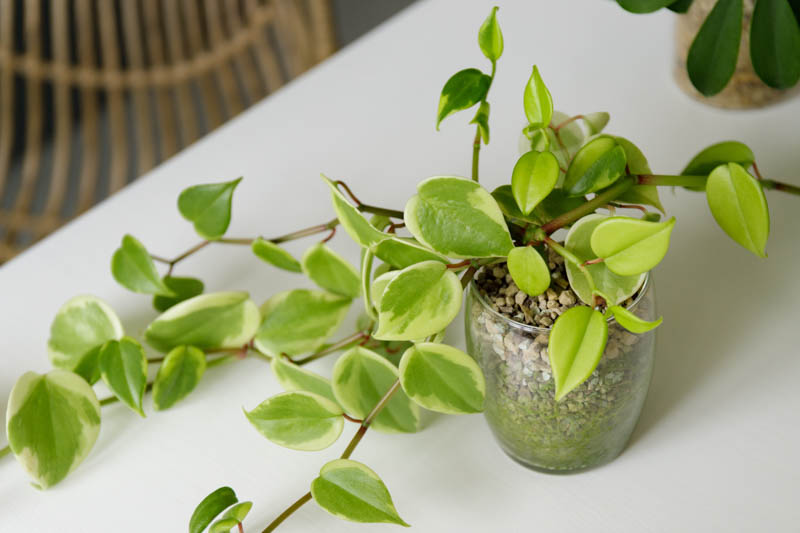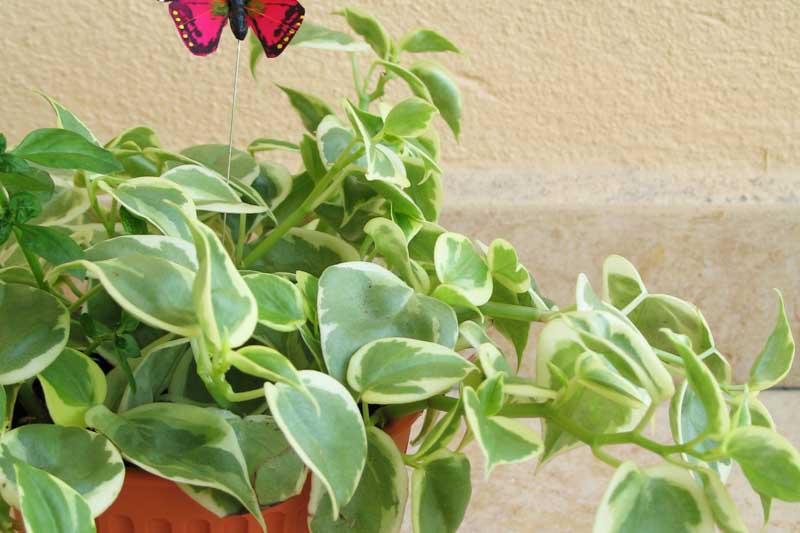Variegated Cupid Peperomia
Peperomia scandens ‘Variegata’, commonly known as the Variegated Cupid Peperomia, is a striking and versatile houseplant that has won the hearts of many with its decorative appeal and easy-care nature.
Peperomia scandens ‘Variegata’ features heart-shaped, glossy leaves that are light green with creamy white or yellow variegation along the edges. The contrast between the variegation and the green center of the leaves makes this plant a visually striking addition to any indoor garden.
Native: Originating from the tropical and subtropical regions of Central and South America, Peperomia scandens is accustomed to the warm and humid conditions found in rainforests, thriving under the canopy of larger trees where light is filtered and humidity is high. It belongs to the pepper family (Piperaceae) and is part of a diverse genus with over 1000 species.
Plant Type and Habit: This perennial evergreen is known for its trailing habit, making it an excellent choice for hanging baskets, trailing over shelves, or climbing with the support of a trellis or moss pole. Its growth is both upward and outward, depending on how it’s supported or allowed to trail.
Size: As a relatively compact plant, Peperomia scandens ‘Variegata’ can reach up to 2-3 feet in length (60-90 cm) when given the space to trail or climb. Its spread depends on the growing conditions and how it’s displayed or supported.
Flowers: Though not grown primarily for its flowers, Peperomia scandens ‘Variegata’ can produce small, greenish-white flower spikes. These subtle spikes do not detract from the plant’s foliage, which is the main attraction.
Foliage: The variegated foliage is the standout feature of this plant. Each heart-shaped leaf, 2 inches long (5 cm), is unique, with variations in the pattern and extent of the variegation, adding to its appeal. The leaves are somewhat succulent, allowing the plant to store water and tolerate periods of drought.
Hardiness: This Peperomia is suited for USDA hardiness zones 10 to 12 if grown outdoors. Indoors, it prefers temperatures between 65°F and 75°F (18°C to 24°C) and moderate to high humidity levels.
Uses: Ideal for adding a touch of greenery to living spaces, especially in hanging baskets or as a tabletop plant with trailing vines. Its tolerance for low-light conditions makes it suitable for office environments or areas with indirect sunlight. It can be used in larger terrariums where its trailing habit and variegated leaves add depth and interest.
Toxicity: This plant is non-toxic to cats, dogs, and humans, making it a safe choice for households with pets and children.
Benefits: Though modest, it contributes to improving indoor air quality.

Caring for Peperomia scandens, including the variegated variety ‘Variegata’, involves straightforward practices that ensure its health and vibrant appearance.
Light: Prefers bright, indirect light. Can tolerate lower light conditions, but its variegation will be more pronounced with adequate lighting. Avoid direct sunlight, which can scorch the leaves.
Soil: Use a well-draining potting mix. A mixture of peat, perlite, and compost works well to ensure adequate drainage and aeration, mimicking its natural tropical habitat.
Water: Water when the top inch of the soil feels dry. Cupid Peperomia does not like to be overwatered, as this can lead to root rot. Reduce watering in the winter months when growth slows down.
Temperature and Humidity: Thrives in average room temperatures between 65°F to 75°F (18°C to 24°C). Avoid exposure to drafts and sudden temperature changes. Enjoys high humidity but can adapt to average household humidity levels. If you notice the leaf edges turning brown or crispy, try to increase humidity around the plant by misting it, placing it on a pebble tray, or using a humidifier.
Fertilization: Fertilize lightly during the growing season (spring to summer) with a balanced, diluted liquid fertilizer once a month. Over-fertilization can harm the plant, so it’s better to err on the side of caution.
Pruning: While generally not necessary, you can prune your Cupid Peperomia to maintain its shape or encourage bushier growth. Use clean, sharp scissors to trim any leggy or overgrown stems.
Repotting: Cupid Peperomia has a small root system and does not require frequent repotting. Repot every 2-3 years or when the plant becomes root-bound, using a slightly larger pot each time.
Propagating Peperomia scandens, commonly known as the Cupid Peperomia, is a straightforward process that can be done using either stem cuttings or leaf cuttings. Here’s how to do it:

Cupid Peperomia s generally a robust and healthy plant, but it can encounter some pests, diseases, and common problems, especially when not provided with optimal care conditions.
Spider Mites: These tiny pests can be identified by the fine webs they weave on the plant. They cause yellowing or speckled leaves. Increase humidity around the plant and wash it with a strong stream of water. For severe infestations, use insecticidal soap or neem oil.
Mealybugs: These white, cottony pests tend to cluster in leaf axils and under leaves, sucking sap and weakening the plant. Remove with alcohol-dipped cotton swabs or apply neem oil.
Fungus gnat: Overwatering can lead to these pests. Let the soil dry out more between waterings, and use yellow sticky traps to catch adult gnats.
Scale insects: Hard or soft-bodied insects that attach themselves to the stems or leaves, causing yellowing and growth stunting. Scrape off with a fingernail or use a cotton swab dipped in rubbing alcohol. Insecticidal soap or neem oil may also be used.
Root rot: Often a result of overwatering, leading to brown, mushy roots and wilted leaves. Prevent by ensuring good drainage and letting the soil partially dry between waterings. Affected plants may need repotting with fresh soil after cutting away any rotten roots.
Leaf spot: Fungal or bacterial infections causing spots on leaves. Avoid wetting foliage when watering and improve air circulation. Remove affected leaves and treat with fungicides if necessary.
Yellowing Leaves: Overwatering is a common cause. Ensure proper watering routines and allow the soil to dry out partially between waterings.
Drooping or Wilting: This can be due to either overwatering or underwatering. Check the soil moisture to determine the cause and adjust your watering accordingly.
Leggy Growth: Insufficient light can cause the plant to stretch towards the light source, resulting in leggy growth. Move your plant to a brighter location with indirect sunlight to encourage compact growth.
Peperomias, including Cupid Peperomia, prefer bright, indirect sunlight. They do not require lots of direct sun and can suffer leaf burn if exposed to too much direct sunlight. They are well-suited to growing indoors, where bright light conditions can be met without direct exposure to the sun.
Yes, Cupid Peperomia is non-toxic and safe for pets. It’s a great choice for households with cats, dogs, or other pets, as it poses no risk if accidentally ingested.
Water your Cupid Peperomia roughly once a week, but only when the top inch of soil has dried out. The frequency of watering will depend on factors such as the light, temperature, and humidity levels in your home. Always check the soil moisture before watering to prevent overwatering. During winter, reduce watering as the plant’s growth slows down.
| Hardiness |
10 - 12 |
|---|---|
| Plant Type | Houseplants, Perennials |
| Plant Family | Piperaceae |
| Genus | Peperomia |
| Exposure | Partial Sun |
| Season of Interest |
Spring (Early, Mid, Late) Summer (Early, Mid, Late) Fall Winter |
| Height |
2' - 3' (60cm - 90cm) |
| Maintenance | Low |
| Water Needs | Average |
| Soil Type | Loam |
| Soil pH | Acid, Neutral |
| Soil Drainage | Moist but Well-Drained |
| Characteristics | Showy, Evergreen |
| Garden Uses | Hanging Baskets, Patio And Containers |
| Hardiness |
10 - 12 |
|---|---|
| Plant Type | Houseplants, Perennials |
| Plant Family | Piperaceae |
| Genus | Peperomia |
| Exposure | Partial Sun |
| Season of Interest |
Spring (Early, Mid, Late) Summer (Early, Mid, Late) Fall Winter |
| Height |
2' - 3' (60cm - 90cm) |
| Maintenance | Low |
| Water Needs | Average |
| Soil Type | Loam |
| Soil pH | Acid, Neutral |
| Soil Drainage | Moist but Well-Drained |
| Characteristics | Showy, Evergreen |
| Garden Uses | Hanging Baskets, Patio And Containers |
How many Peperomia scandens ‘Variegata’ (Variegated Cupid Peperomia) do I need for my garden?
| Plant | Quantity | |
|---|---|---|
| Peperomia scandens ‘Variegata’ (Variegated Cupid Peperomia) | N/A | Buy Plants |
Create a membership account to save your garden designs and to view them on any device.
Becoming a contributing member of Gardenia is easy and can be done in just a few minutes. If you provide us with your name, email address and the payment of a modest $25 annual membership fee, you will become a full member, enabling you to design and save up to 25 of your garden design ideas.
Join now and start creating your dream garden!
Create a membership account to save your garden designs and to view them on any device.
Becoming a contributing member of Gardenia is easy and can be done in just a few minutes. If you provide us with your name, email address and the payment of a modest $25 annual membership fee, you will become a full member, enabling you to design and save up to 25 of your garden design ideas.
Join now and start creating your dream garden!